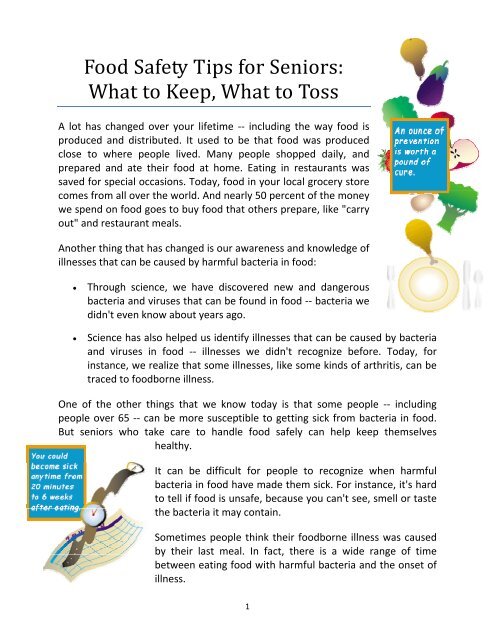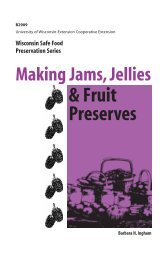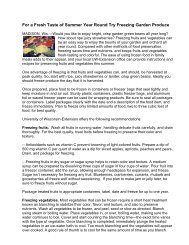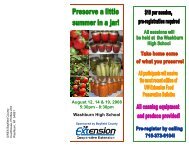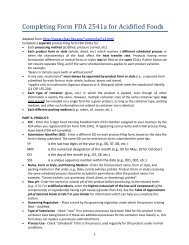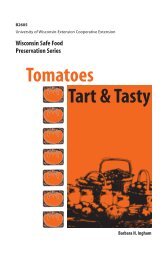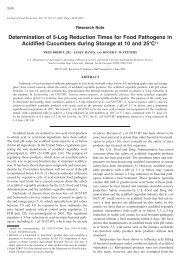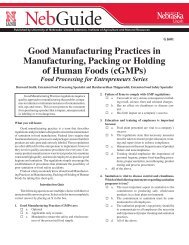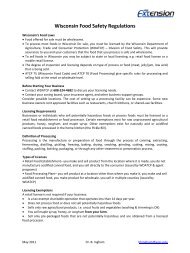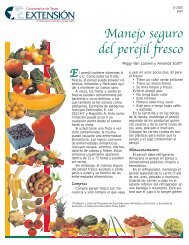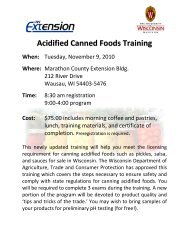Food Safety Tips for Seniors - UW Food Safety and Health
Food Safety Tips for Seniors - UW Food Safety and Health
Food Safety Tips for Seniors - UW Food Safety and Health
- No tags were found...
Create successful ePaper yourself
Turn your PDF publications into a flip-book with our unique Google optimized e-Paper software.
<strong>Food</strong> <strong>Safety</strong> <strong>Tips</strong> <strong>for</strong> <strong>Seniors</strong>:What to Keep, What to TossA lot has changed over your lifetime ‐‐ including the way food isproduced <strong>and</strong> distributed. It used to be that food was producedclose to where people lived. Many people shopped daily, <strong>and</strong>prepared <strong>and</strong> ate their food at home. Eating in restaurants wassaved <strong>for</strong> special occasions. Today, food in your local grocery storecomes from all over the world. And nearly 50 percent of the moneywe spend on food goes to buy food that others prepare, like "carryout" <strong>and</strong> restaurant meals.Another thing that has changed is our awareness <strong>and</strong> knowledge ofillnesses that can be caused by harmful bacteria in food:• Through science, we have discovered new <strong>and</strong> dangerousbacteria <strong>and</strong> viruses that can be found in food ‐‐ bacteria wedidn't even know about years ago.• Science has also helped us identify illnesses that can be caused by bacteria<strong>and</strong> viruses in food ‐‐ illnesses we didn't recognize be<strong>for</strong>e. Today, <strong>for</strong>instance, we realize that some illnesses, like some kinds of arthritis, can betraced to foodborne illness.One of the other things that we know today is that some people ‐‐ includingpeople over 65 ‐‐ can be more susceptible to getting sick from bacteria in food.But seniors who take care to h<strong>and</strong>le food safely can help keep themselveshealthy.It can be difficult <strong>for</strong> people to recognize when harmfulbacteria in food have made them sick. For instance, it's hardto tell if food is unsafe, because you can't see, smell or tastethe bacteria it may contain.Sometimes people think their foodborne illness was causedby their last meal. In fact, there is a wide range of timebetween eating food with harmful bacteria <strong>and</strong> the onset ofillness.1
REFRIGERATOR STORAGE CHART<strong>Food</strong> ItemEGGSFresh eggs, in shellHard cookedEgg substitutes, openedEgg substitutes, unopenedDAIRY PRODUCTSMilkCottage cheeseYogurtMayonnaiseDELI FOODSEntrees, cold or hotDeli meats – sliced ham, turkey, beefStore‐prepared or homemade saladsHOT DOGS AND LUNCHEON MEATSHot dogs, opened packageHot dogs, unopened packageLuncheon meats, openedLuncheon meats, unopenedLEFTOVERSCooked meat, meat or egg dishes, soups,stews <strong>and</strong> vegetablesGravy <strong>and</strong> meat brothCooked fish <strong>and</strong> poultryFRESH MEATSteaks or roastsChicken or turkey, whole or piecesFresh meatPROCESSED MEATBaconCanned ham (label says ‘Keep Refrigerated’Ham, fully cookedSausage, rawPrecooked sausage breakfast links/patties*Freeze <strong>for</strong> longer storage.Refrigerator (40°F)4‐5 weeks1 week3 days10 days*1 week1 week1‐2 weeks2 months3‐4 days2‐3 days3‐5 days1 week2 weeks*3‐5 days2 weeks3‐4 days*1‐2 days*3‐4 days*3‐5 days*1‐2 days*1‐2 days*1 week*6‐9 months3‐5 days*1‐2 days*1 week*3
Fresh fruits <strong>and</strong> vegetables also require special care. Most fruits <strong>and</strong> vegetablesshould be stored in the refrigerator, but some, such as bananas, willretain quality <strong>for</strong> a longer period if stored on the counter. Ask yourgrocer how to store fruits <strong>and</strong> vegetables if you aren’t sure.All produce purchased pre‐cut or peel should be refrigerated <strong>for</strong>safety as well as quality. Pre‐cut melons must be kept refrigerated;if left out <strong>for</strong> more than 2 hours they should be discarded.Take Time to Treat Take‐Out <strong>and</strong> Delivered <strong>Food</strong>s Properly!Let's face it. Sometimes it's just easier <strong>and</strong> more enjoyable to let someone else dothe cooking. Hot or cold ready‐prepared meals are perishable <strong>and</strong> can causeillness when mish<strong>and</strong>led. Proper h<strong>and</strong>ling is essential to ensure the food is safe!HOT FOODS: Hot foods that you purchase or are delivered to your home need tobe kept hot (145°F) <strong>and</strong> eaten within 2 hours. If dishes will not be eaten within 2hours‐‐refrigerate the food <strong>and</strong> then reheat to bubbling hot when you are readyto eat. COLD FOODS should be eaten within 2 hoursor refrigerated or frozen <strong>for</strong> eating at another time.When reheating food, heat thoroughly to 165°F,until bubbling hot. If heating in a microwave oven,cover food <strong>and</strong> rotate the dish so the food heatsevenly <strong>and</strong> doesn’t leave ‘cold spots’ that couldharbor bacteria.For other questions on the safety of food, consultthe University of Wisconsin Extension program officein your county.Remember: When in Doubt, Throw it Out!An ounce of prevention is worth a pound of cure.B.Ingham. 03/094


